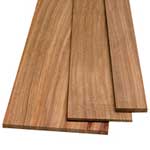
If a S4S board is already planed down and smooth, why is it necessary to sand the S4S board again?
John Brock: If it’s for an outdoor project, I probably wouldn’t bother sanding. If the board will be used as part of a more formal, indoor project, then sanding will remove the planer marks.
Tim Inman: If the wood was planed conventionally with spinning cutter knives, there will be little corduroy ripples left behind. You may not see them now, but you will once you stain and finish. Sanding removes those machine marks. If the wood was “planed” using a drum sander, then you’ll want to do a fine finish sanding to remove the coarser drum sander scratches.
Michael Dresdner: There are two reasons to sand smoothed wood. The first, as Tim and John said, is to remove planer or sander marks that may not even be visible in the raw wood. The second has to do with adhesion. The longer a wood surface is exposed to air, the more it oxidizes, which diminishes adhesion of both glues and finishes. Thus, you should always surface or sand wood just before glue-up or finishing, even if it is already smooth.





